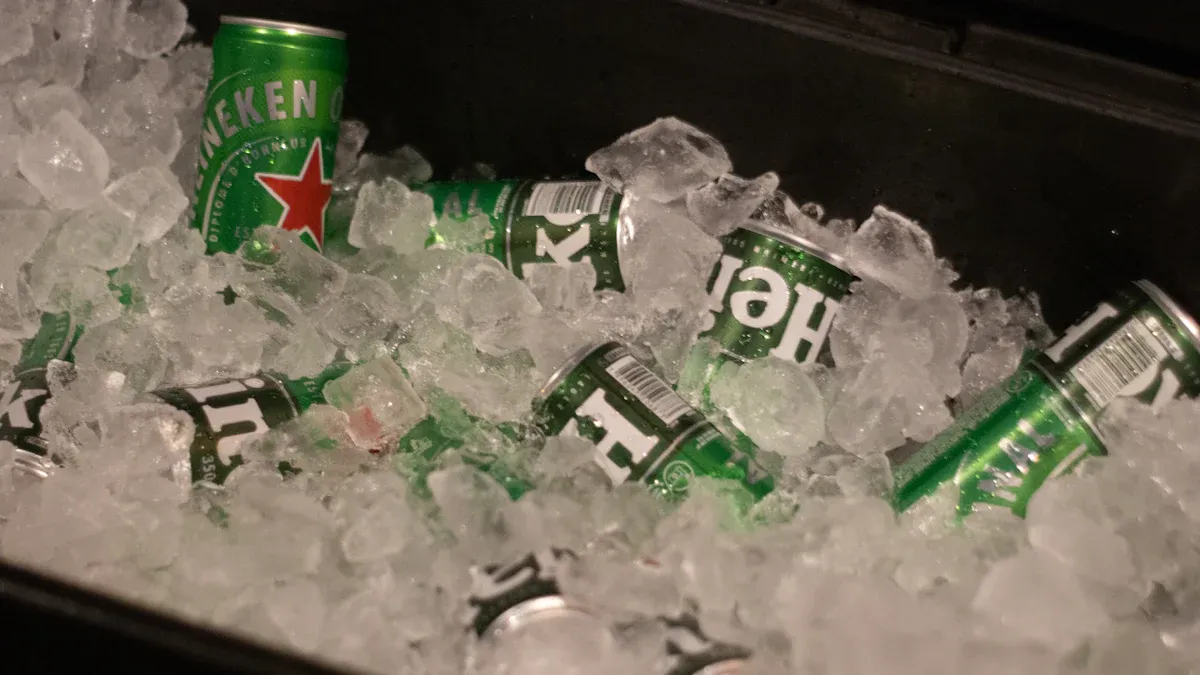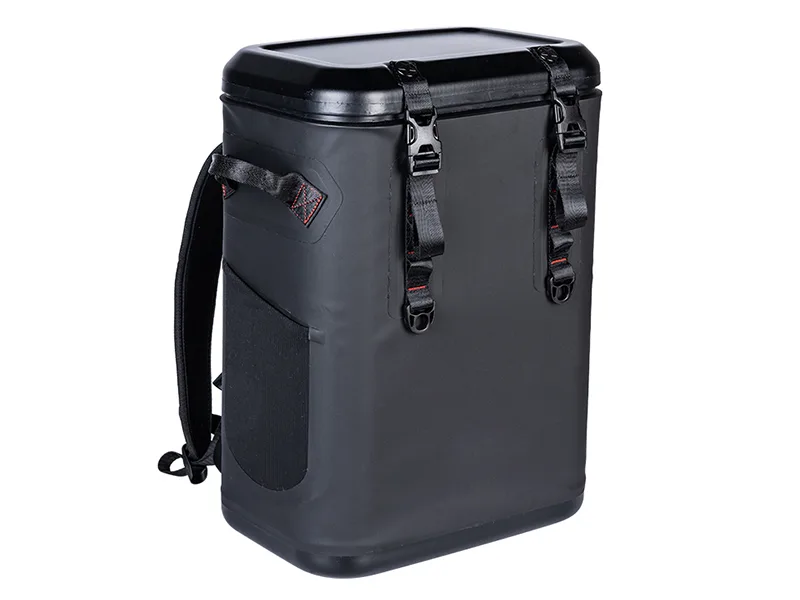
When you look for the best cooler to keep your drinks cold and your ice frozen, YETI stands out as the top huge cooler box brand. You want a cooler that stays cold for days, handles rough trips, and keeps your food and drinks safe. YETI, RTIC, Igloo, KUER, Pelican, Coleman, and Blue Coolers all compete, but YETI leads in insulation and durability. Some models like Coleman and Igloo can lose ice faster because of weaker seals. YETI and KUER use strong materials, so your cooler lasts longer and keeps ice solid. Check out this chart to see how long each cooler holds ice:
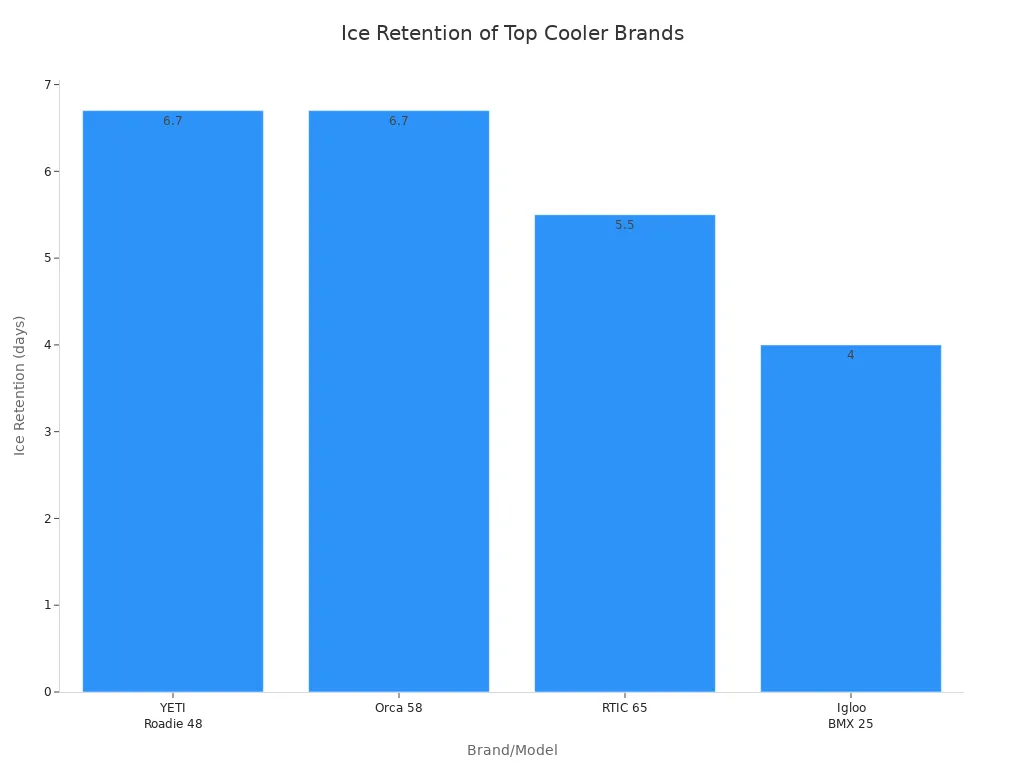
You want the best cooler for every trip, whether you need to keep ice for a weekend or keep drinks cool for a big group.
Key Takeaways
- YETI leads in ice retention and durability, keeping ice frozen for up to 10 days with strong insulation and tough build.
- Look for coolers with thick insulation, tight seals, and rotomolded construction to keep your food and drinks cold longer.
- Portability matters: choose coolers with wheels, strong handles, or backpack straps to move them easily on trips.
- Match your cooler size and features to your trip length and group size for the best experience and value.
- Budget options like RTIC and Coleman offer good performance, but premium brands provide longer ice retention and greater durability.
Huge Cooler Box Quick Comparison Table
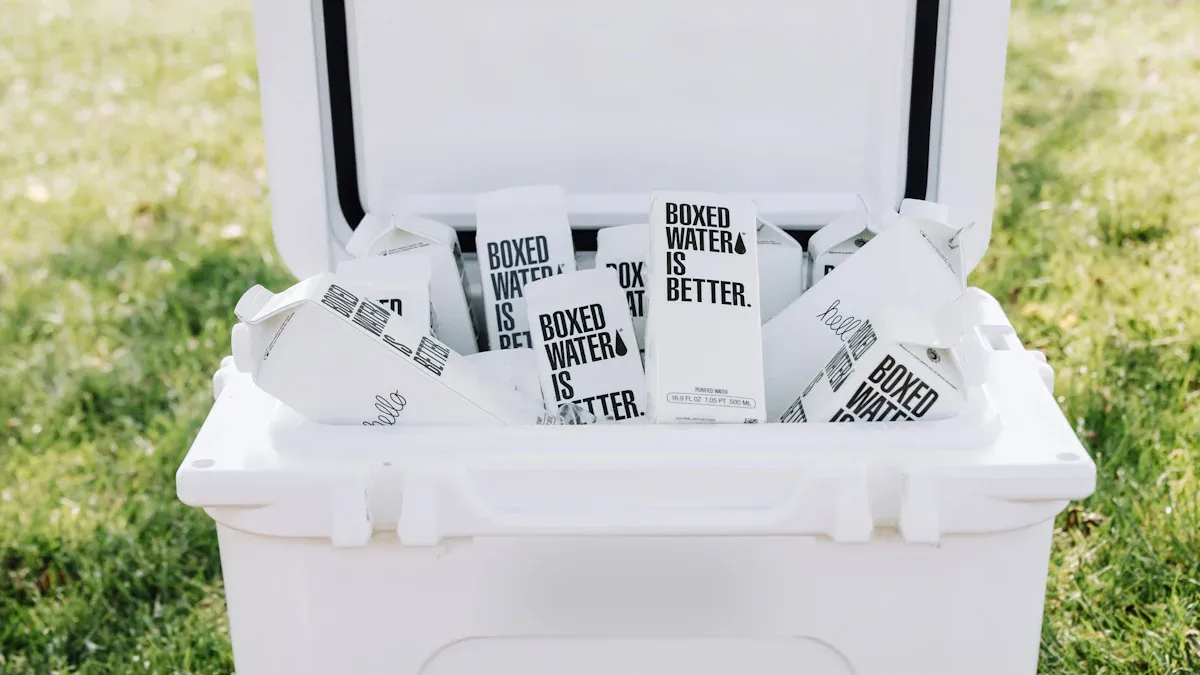
Top Cooler Brands and Models Compared
When you want to pick the right huge cooler box, it helps to see how the top brands stack up. You can find many cooler models, but the best ones stand out for their ice retention, build, and capacity. Here’s a quick look at how some of the most popular brands compare in terms of ice retention, insulation, and price:
| Brand | Ice Retention Duration | Insulation Type & Thickness | Notes on Performance & Price |
|---|---|---|---|
| Yeti Tundra | Up to 10 days | 2-inch Permafrost (industrial-grade) | Leading ice retention; premium price; IGBC certified |
| Calcutta Renegade | Up to 10 days | Similar 2-inch thick industrial-grade | Comparable or better than Yeti in some sizes; more affordable |
| Orca | Up to 10 days | Not specified | Comparable to Yeti; IGBC certified; handles less comfortable |
| RTIC | Up to 10 days | Not specified | Value alternative; slightly less durable latches |
| Grizzly | Not stated | Not specified | Comparable price to Yeti; lacks clear ice retention data |
| Igloo Maxcold | Up to 5 days | Not specified | Affordable; less ice retention than premium brands |
| Pelican Elite | Not clearly stated | Not specified | Ice retention data unavailable |
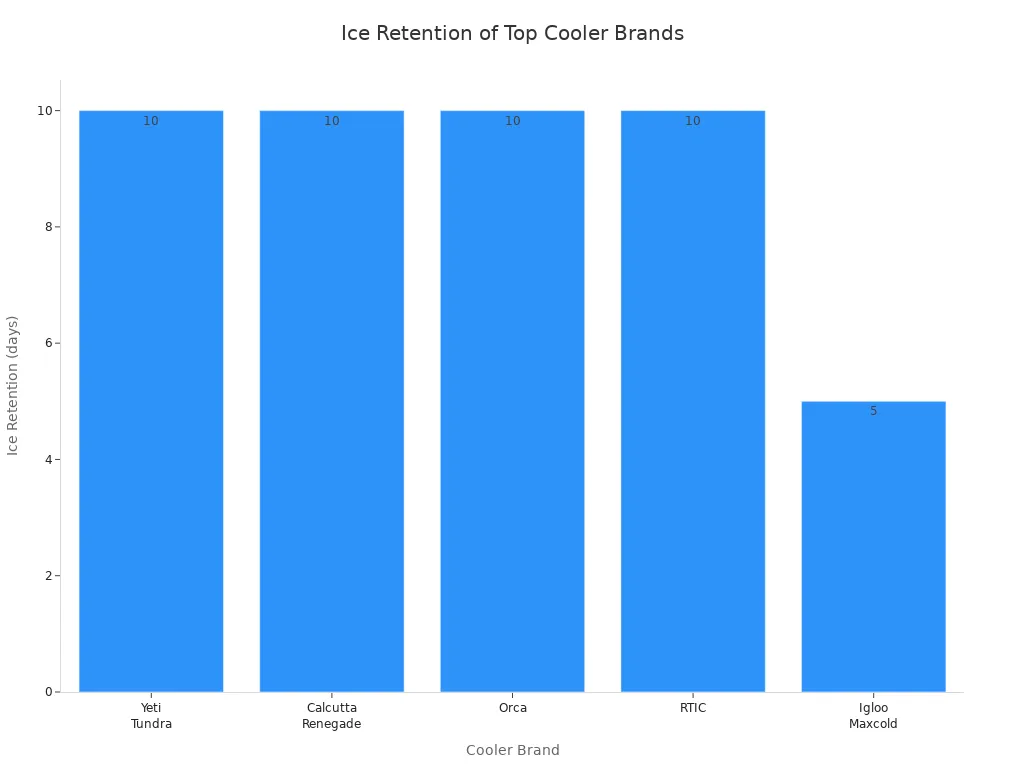
You can see that Yeti, Calcutta, Orca, and RTIC all offer up to 10 days of ice retention. Igloo Maxcold keeps ice for about 5 days. The insulation type and thickness make a big difference in how long your cooler stays cold. If you need a huge cooler box for a long trip or a big group, these numbers matter.
Key Performance Metrics Overview
When you compare huge cooler box brands, you want to focus on the features that matter most. Here are the key things you should look for:
- Ice retention and cooling capabilities: The best coolers keep ice for days, even in hot weather. This is important if you need to store food or drinks for a long time.
- Weight and portability: Large coolers can get heavy, especially when full. Some have wheels to help you move them, which is great for camping or tailgating.
- Wheeled cooler features: Rolling coolers make it easier to move a big cooler, but they can be bulkier. Think about where you will use your cooler most.
- Durability and longevity: A high-quality cooler can last for years. Strong materials and good construction mean your cooler can handle rough trips and heavy use.
- Capacity and size: Make sure the cooler has enough capacity for your needs. Check the size so you know it will fit in your car or boat.
Tip: Always match the capacity and size of your huge cooler box to your group size and trip length. You don’t want to run out of space or carry more weight than you need.
Why YETI Is the Best Cooler
Insulation and Ice Retention
When you want your drinks cold and your food safe, you need a cooler that keeps ice frozen for days. YETI stands out because of its thick insulation and smart design. The company uses rotomolded construction and pressure-injected polyurethane foam, which means the walls are thick and packed with insulation. This design helps the cooler hold ice longer, even in hot weather.
You can see how YETI compares to other brands in real-world tests. OutdoorGearLab tested the YETI Tundra 65 without any special prep. The cooler kept temperatures below 40°F for about 115 hours, which is almost five days. Even after that, it stayed under 50°F for over five days. Taste of Home put the YETI Tundra 45 in a van during a heatwave. After four days, there was still ice inside. By day five, the ice was gone, but the inside was still cool at 54°F. That’s impressive insulation.
Let’s look at how YETI stacks up against other coolers in multi-day ice retention:
| Cooler Model | Ice Retention Duration | Notes |
|---|---|---|
| YETI Tundra 65 | Just over 7 full days | Retains ice about 7 days in summer heat when kept in shade and opened infrequently. |
| RTIC 65 | Just over 7 full days | Matches YETI’s performance under similar conditions. |
| Pelican | Barely 7 days | Only a few ice cubes left at 7 days, indicating slightly lower performance. |
| Igloo | N/A | No specific ice retention duration provided, so no direct comparison available. |
| Orion Core | Over 9 days | Outperforms YETI and RTIC in ice retention duration. |
| Cabela’s Polar Cap | Over 9 days | Also outperforms YETI and RTIC in ice retention duration. |

YETI’s insulation is top-notch. The Tundra 65 and Roadie 48 both use thick, rotomolded walls and freezer-style gaskets. These features help the cooler keep ice for up to 10 days in some models. You get peace of mind knowing your food and drinks stay cold, even on long trips.
Durability and Build Quality
You want a hard cooler that can handle bumps, drops, and rough roads. YETI coolers are famous for their durability. The rotomolded construction creates a seamless, one-piece shell. This means there are no weak spots or cracks where the cooler could break. The FatWall design adds even more strength, with thick walls that protect the insulation and keep the cooler solid.
Here’s what makes YETI’s build quality stand out:
- Rotomolded construction forms a tough, one-piece shell.
- FatWall design gives you thicker walls for better insulation and strength.
- PermaFrost high-density foam insulation keeps the cold in and the heat out.
- T-Rex lid latches use heavy-duty rubber for a tight, secure seal.
- Bearfoot non-slip feet stop the cooler from sliding around in your truck or boat.
- ColdLock gasket creates an airtight seal between the lid and the body.
- AnchorPoint tie-down slots let you secure your hard cooler during transport.
YETI uses advanced materials like fiber-reinforced thermoplastics, sometimes with carbon fiber or Kevlar, to boost strength. The company uses fusion bonding and special molding techniques to make sure every cooler is tough. Some coolers even pass grizzly bear resistance tests. That’s real-world durability you can trust.
YETI also backs its hard coolers with a five-year warranty. This warranty covers defects in materials and workmanship, so you know your investment is protected. Most other brands don’t offer this level of coverage.
| Product Categories | Warranty Period | Coverage Details | Exclusions and Conditions |
|---|---|---|---|
| Hard Coolers and Drinkware (e.g., Tundra, V Series, Roadie, Rambler) | 5 years | Covers defects in workmanship and materials. Replacement of non-conforming products. | Excludes normal wear and tear, punctures, scratches, damage from misuse, and products bought outside the US or unauthorized channels. |
User Experience and Feedback
When you read what users say about YETI, you see a pattern. People love the cooler’s durability and insulation. Many call the Tundra series “bomb-proof” because it stands up to rough handling, bumps, and even drops. You can take a YETI hard cooler camping, fishing, or tailgating, and it will keep ice for days.
Here’s what users like most:
- Rotomolded construction means the cooler lasts for years, even with heavy use.
- The QuickLatch system is easy to use with one hand and keeps the cooler sealed tight.
- YETI coolers meet bear-resistant standards, so you can use them in bear country.
- Ice retention is class-leading, making these coolers perfect for long trips.
- Leak resistance is better than many other brands.
- You can pick from a wide range of sizes and colors.
- The latch systems, especially the QuickLatch, are user-friendly.
Some users mention that YETI coolers are heavy and cost more than other brands. The thick insulation takes up some internal space, but most people accept this because it means better performance. Many users say the cooler is worth the price because it lasts so long and keeps ice frozen for days.
You also get practical features like dry goods baskets and strong lid latches. These make it easy to organize your food and drinks. The cooler cools room-temperature drinks quickly, so you don’t have to wait long for a cold soda.
Customer satisfaction ratings show that YETI is the premium choice for those who want the best cooler. RTIC offers similar quality at a lower price, but YETI leads in insulation, durability, and long-term value. Coleman and Igloo are good for smaller budgets, but they don’t match YETI’s performance or build quality.
Tip: If you want a hard cooler that keeps ice frozen, stands up to tough trips, and lasts for years, YETI is the best cooler for you.
Huge Cooler Box Performance Breakdown by Category
Insulation Performance
When you pick a cooler, insulation is the first thing you want to check. Good insulation keeps your ice frozen and your drinks cold, even when the sun is blazing. Most top brands use thick walls and special foam to trap cold air inside. For example, YETI uses injected polyurethane foam in its hard cooler walls, making them extra thick—sometimes up to 3 inches. RTIC coolers also use rotomolded construction, but their insulation is a bit thinner. Igloo coolers do not always share details about their insulation, so you might not know what you are getting.
Here’s a table showing how long each cooler can keep ice in a hot garage:
| Cooler Brand | Initial Ice Weight | Ice Retention Time (hours) | Ice Remaining at 53.5 hours | Notes |
|---|---|---|---|---|
| Igloo Leeward | 20 lbs | 28 to 53.5 (zero ice) | 0 lbs | Lost all ice between 28 and 53.5 hours |
| Igloo BMX | 20 lbs | 28 to 53.5 (zero ice) | 0 lbs | Lost all ice between 28 and 53.5 hours |
| YETI Tundra 45 | 20 lbs | 53.5 to 77 (zero ice) | 4 lbs | Lost all ice between 53.5 and 77 hours |
| Otter Box Venture 45 | 20 lbs | >77 hours (1 lb remaining) | 9 lbs | Still had 1 lb ice at 77 hours; best retention |
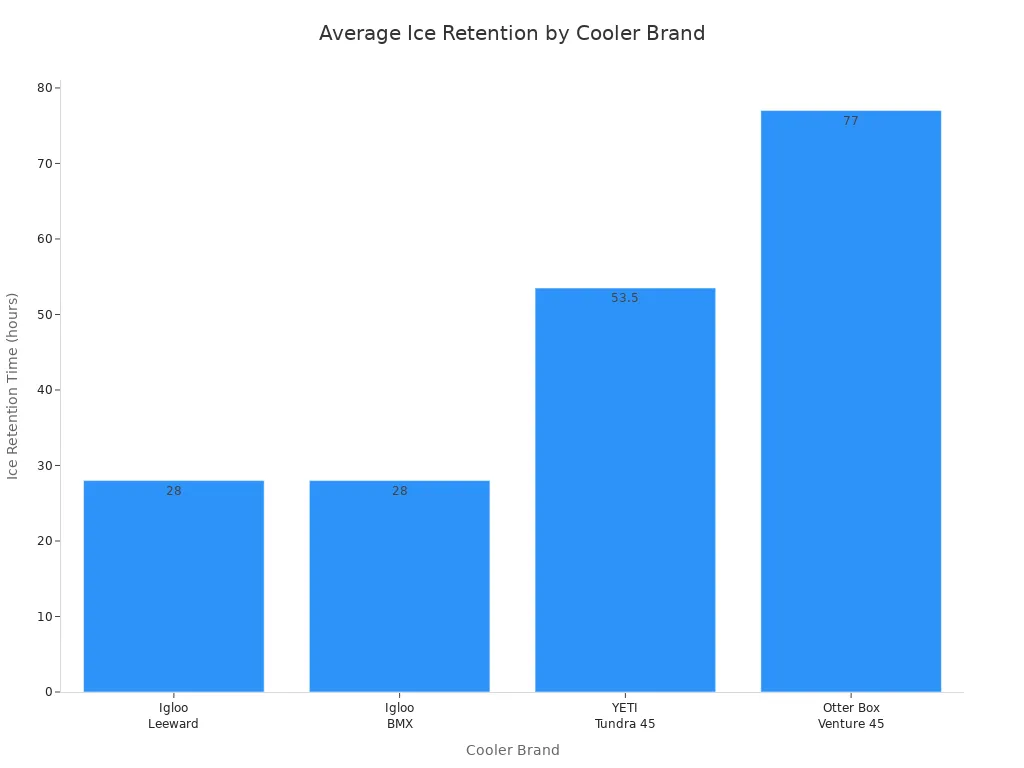
You can see that the YETI hard cooler holds ice much longer than Igloo. Otter Box even beats YETI in this test, but both are great for long trips. If you want your cooler to last through a weekend, look for thick insulation and a tight seal.
Durability and Materials
Durability matters when you take your cooler outdoors. You want a hard cooler that can handle drops, bumps, and rough roads. Most top coolers use rotomolded plastic, which makes the shell strong and seamless. YETI, RTIC, and other brands use this method to make sure your cooler does not crack or break.
Here’s what happens in real-world durability tests:
- Coolers get dropped from a tall ladder three times, landing on their edges or sides.
- Testers throw firewood across the lids to check for scratches.
- People walk, run, and even jump on the coolers.
- A 25-pound anchor gets dropped on the lid, leaving only small dents.
- Even after all this, the coolers stay strong and keep their shape.
You can trust a hard cooler with rotomolded construction to last for years. The materials protect the insulation inside and keep your food safe. Some coolers, like Otter Box, show almost no marks after these tests. Others might get a few scratches, but they still work just as well.
Ease of Use and Features
A cooler should not just be tough—it should also be easy to use. YETI coolers get high marks for user-friendly features. The Tundra Haul has strong wheels, so you can roll your hard cooler instead of carrying it. The Roadie 48 has a telescoping handle, making it simple to move, even when full. Some coolers have fold-away handles, metal bottle openers, and baskets for dry goods. These features make your trip easier.
- Many users like the magnetized seal on the M20 backpack cooler. It closes tight without a zipper.
- Some coolers have drain plugs that are not attached, so you need to be careful not to lose them.
- The size and capacity of your cooler matter, too. Make sure you pick a cooler that fits your group and trip length.
Tip: Look for a cooler with the right features for your needs. Wheels, handles, and baskets can make a big difference when you are on the go.
Portability and Weight
When you pick a huge cooler, portability matters a lot. You want to move your cooler easily, even when it’s full of ice, food, and drinks. Some coolers can get heavy, especially with a large capacity. You need smart features that help you carry or roll your cooler without a struggle.
Most extra-large coolers weigh between 11 and 28 pounds when empty. The YETI Roadie 48 weighs about 28 pounds, but it comes with puncture-resistant wheels and a telescoping handle. These features make it easy to pull your cooler over grass, gravel, or sand. The Coleman 316 Series 70 QT is much lighter at just over 11 pounds. It has molded handles, so you can carry it solo if needed. The RTIC Ultra-Light 52 weighs 21 pounds and uses molded side handles and nylon rope handles with rubber grips. These features make it comfortable to carry, even when packed with drinks and ice.
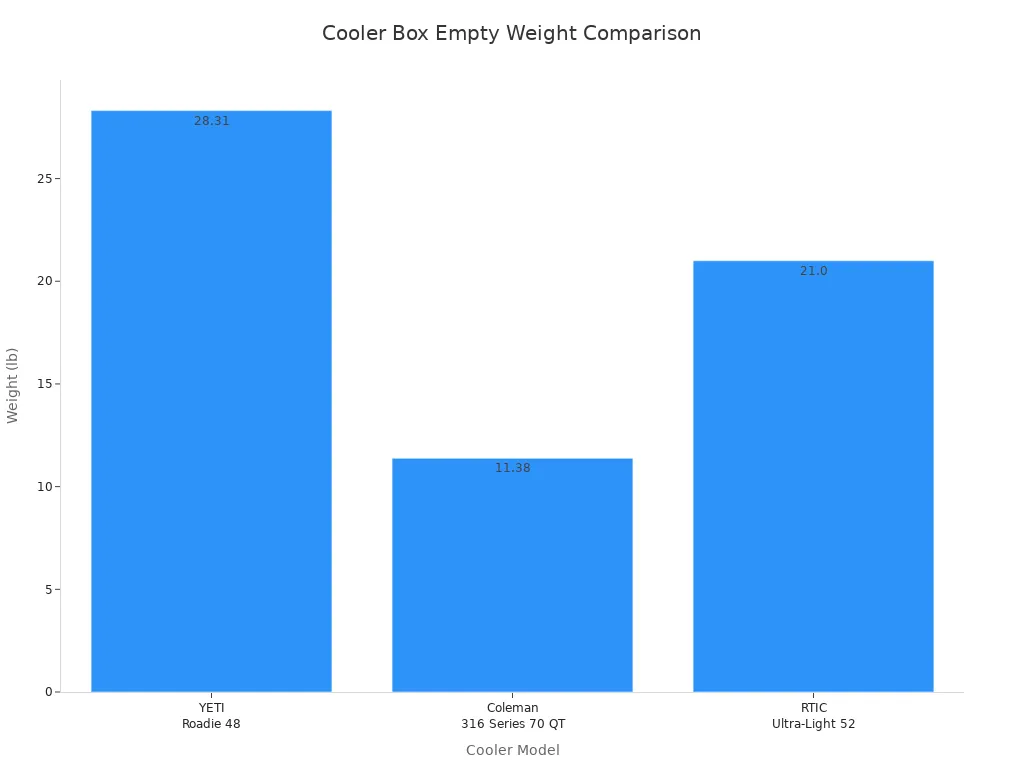
Here’s a quick look at how some top coolers compare for portability:
| Cooler Model | Weight (Empty) | Portability Features | Portability Highlights |
|---|---|---|---|
| YETI Roadie 48 | 28 lb. 5 oz. | Puncture-resistant wheels, periscoping handle, molded handles | Wheels for rough terrain, ergonomic handles, easy to pull |
| Coleman 316 Series 70 QT | 11 lb. 6 oz. | Molded handles | Lightweight, easy to carry solo |
| RTIC Ultra-Light 52 | 21 lb. | Molded side handles, nylon rope handles with rubber grips | Lightweight, comfortable carrying options |
Some coolers, like the DIYION series, offer different capacity options with ergonomic handles. You can choose a 6L, 13.5L, or 22L cooler, each designed for easy transport. These features help you pick the right cooler for your trip, whether you need to carry it to a picnic or roll it to a campsite.
Tip: If you plan to move your cooler often, look for wheels, strong handles, and lightweight designs. These features boost portability and make your adventure easier.
Value for Money
You want a cooler that gives you the best value for your money. Some coolers cost more because they offer premium features, better insulation, and higher durability. Others focus on affordability and basic features. Think about how you will use your cooler and what features matter most to you.
A cooler with a large capacity can hold more drinks and food, which is great for big groups. Premium coolers like YETI and RTIC often come with extra features such as wheels, strong handles, and thick insulation. These features help your cooler last longer and keep your drinks cold for days. Lightweight coolers like the Coleman 316 Series 70 QT give you good capacity and easy portability at a lower price. You might not get all the premium features, but you still get a cooler that works well for most trips.
When you compare coolers, check the features list. Look for things like drain plugs, dry goods baskets, and tie-down points. These features add value and make your cooler more useful. Some coolers even have special handles or wheels for better portability. You get more for your money when your cooler matches your needs.
Note: Always balance the price with the features and capacity you need. A cooler with the right features and good portability can make every trip more enjoyable.
Best Coolers for Specific Needs
Best Cooler for Camping
When you plan a camping trip, you want a cooler that keeps your food and drinks cold for days. You also need something tough and easy to move. The best cooler for camping should have strong insulation, solid wheels, and handles that make it easy to pull or carry. You might also want a soft cooler or a backpack cooler for short hikes or quick trips from your campsite.
Here’s a quick look at some top camping coolers:
| Cooler Box Model | Capacity (liters) | Ice Retention Duration | Key Features & Durability | Portability Features | Price Range & Notes |
|---|---|---|---|---|---|
| Yeti Roadie 48 Wheeled | 48 | Up to 5 days (tested 5d 20h) | PermaFrost™ foam, Interlock™ lid, ColdLock™ gasket, Quicklatch™, seamless plastic | Puncture-resistant wheels, easy to pull | Premium, highly durable, best cooler for camping |
| Coleman Pro 55QT Wheeled | 52 | Not specified, good | Large capacity, rugged design | Wheeled, less maneuverable | Cheaper, very large size |
| Cooler with Polyurethane Foam Insulation | 24, 42.5, 52 | 3.5 to 5 days (size dependent) | Thick foam, metal latch, antibacterial liner, rugged casing | Side handles, padded strap | Mid-range, sturdy, good ice retention |
| Coleman 28QT Xtreme Marine | 26 | ~3 days | UVGuard, cup holders, robust lid | Swing handle, no wheels | Affordable, good for weekends |
| Campingaz Icetime Plus | 26 | ~24 hours (tested nearly 3 days half filled with ice) | Thick foam, locking handle, robust shell | Swing handle, no wheels | Budget, short trips |
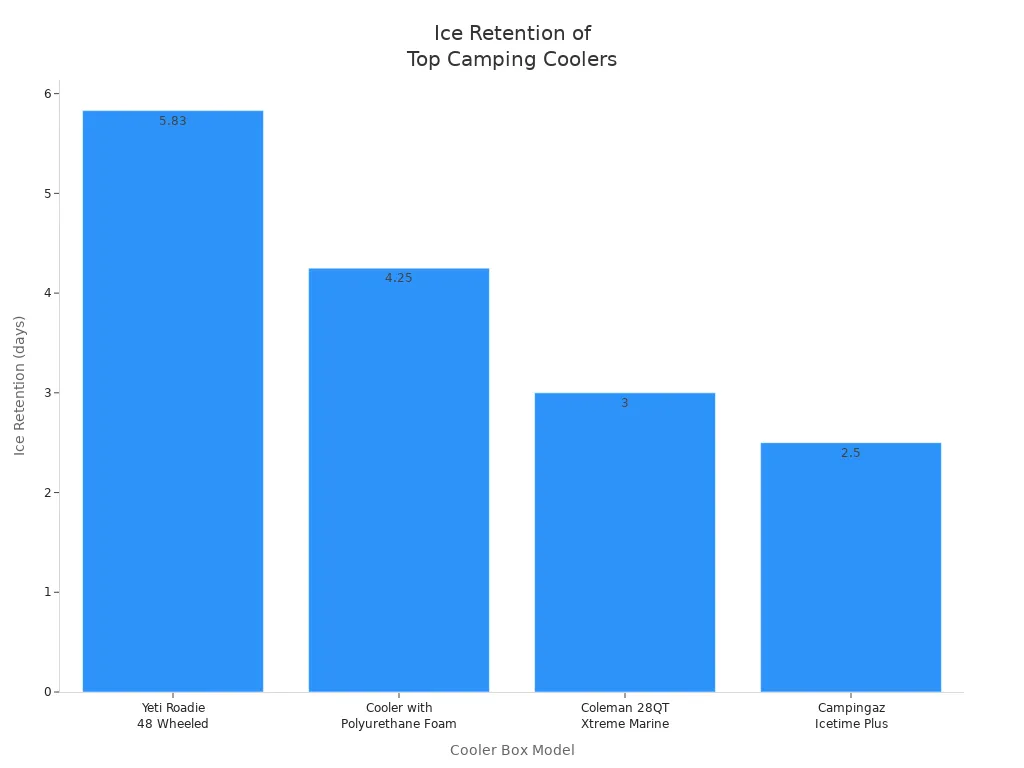
You can see that the Yeti Roadie 48 Wheeled stands out for ice retention and durability. Its wheels and handles boost portability, so you can move it over rough ground. If you want a soft cooler or a backpack cooler for day hikes, look for one with thick insulation and padded straps. The best backpack cooler keeps your drinks cold and your hands free.
Best Cooler for Long Trips
Long trips need a cooler with big capacity and strong ice retention. You want to pack enough food and drinks for several days. The best cooler for long trips should have thick insulation, a tight seal, and sturdy handles or wheels for easy portability. Some people like to bring a soft cooler or a backpack cooler for extra snacks or drinks on the go.
Look for these features:
- Large capacity (at least 48 liters)
- Wheels or strong handles for portability
- Thick foam insulation for long ice retention
- Easy-to-clean liner
A hard cooler with these features will keep your supplies cold for days. If you want to carry drinks on a hike, the best backpack cooler is a smart choice. It fits on your back and keeps your hands free. You can also use a soft cooler for quick trips from your main camp.
Tip: For long trips, pack a hard cooler for main storage and a soft cooler or backpack cooler for daily use.
Best Cooler on a Budget
You do not have to spend a lot to get a good cooler. Many budget coolers offer solid performance, decent capacity, and helpful features. If you want something light and easy to carry, try a soft cooler or a backpack cooler. These coolers work well for picnics, short trips, or as a backup to your main cooler.
Budget-friendly coolers often have:
- Medium capacity (20–30 liters)
- Simple handles for portability
- Basic foam insulation
- Lightweight design
The Coleman 28QT Xtreme Marine and Campingaz Icetime Plus are great choices. They keep ice for a couple of days and are easy to carry. If you want the best soft cooler or the best backpack cooler, check for padded straps and leak-resistant liners. These features make your trip easier and keep your food safe.
Note: Always match your cooler’s capacity and features to your trip. A soft cooler or backpack cooler adds flexibility and boosts portability.
Best Cooler for Portability
When you want to move your cooler with ease, portability becomes the most important factor. You need a cooler that rolls smoothly, handles rough ground, and doesn’t slow you down. The best coolers for portability combine smart design with practical features. A cooler with wheels makes a huge difference, especially when you pack it full for a day at the park or a weekend camping trip.
The 70-Quarts Adventure Cooler Box from Vanhunks USA stands out for portability. This cooler comes with built-in wheels that let you roll it over grass, gravel, or pavement. You don’t have to lift heavy loads. The cooler also has heavy-duty rubber T handles, a pressure release valve, non-slip feet, and a freezer-style lid gasket. These features help you move the cooler easily and keep your food cold. The locking system adds security when you travel.
If you want something lighter, a soft cooler or a backpack cooler offers even more portability. A soft cooler is easy to carry and fits in tight spaces. You can sling a backpack cooler over your shoulders and keep your hands free. The best backpack cooler gives you comfort and keeps your drinks cold on a hike or a walk to the beach.
Here are some tips to boost portability:
- Choose a cooler with wheels for heavy loads.
- Pick a soft cooler for quick trips or picnics.
- Try a backpack cooler for hands-free carrying.
- Look for coolers with padded straps and ergonomic handles.
Tip: Portability matters most when you move your cooler often. Wheels, handles, and lightweight designs make every trip easier.
Best Cooler for Large Groups
Planning for a big event or a family gathering? You need a cooler that holds enough drinks and snacks for everyone. The best coolers for large groups offer big capacity, strong insulation, and easy access. You want a cooler that keeps everything cold and is simple to move, even when full.
Check out this table comparing top-rated coolers for large groups:
| Cooler Model | Capacity (quarts/cans) | Dimensions (inches) | Weight (empty) | Key Features & Pros | Cons |
|---|---|---|---|---|---|
| BrüMate 55-Quart Rolling | 55 quarts / 48 cans | 19.5 x 32 x 19.5 | 44.5 lbs | Rugged wheels, excellent ice retention (up to a week), built-in tap and bottle opener, slip-proof top | Heavy and bulky |
| Yeti Tundra 65 Cooler | ~20 quarts / 30 cans | 12 x 10 x 8 | 4 lbs | Durable nylon, excellent insulation | Smaller capacity for large groups |
| Yeti Tundra Haul Cooler | 58 quarts / 45 cans (2:1 ice ratio) | 28.3 x 18.6 x 19.5 | 37.5 lbs | Bear-proof, wheels with folding handle, extremely durable, excellent insulation | No lifting handles, expensive |
| Engel HD30 Cooler Bag | 30 quarts / 60 cans | 20.5 x 9.5 x 17 | 5.3 lbs | Multiple handles, waterproof, drainage plug, bottle opener | Heavy when fully loaded |
| RTIC Backpack Soft Cooler | 30 cans + bag of ice | 20.25 x 15 x 10 | 3.8 lbs | Leakproof, floats, comfortable padded straps, good cold retention | Water bottle holders prone to wear |
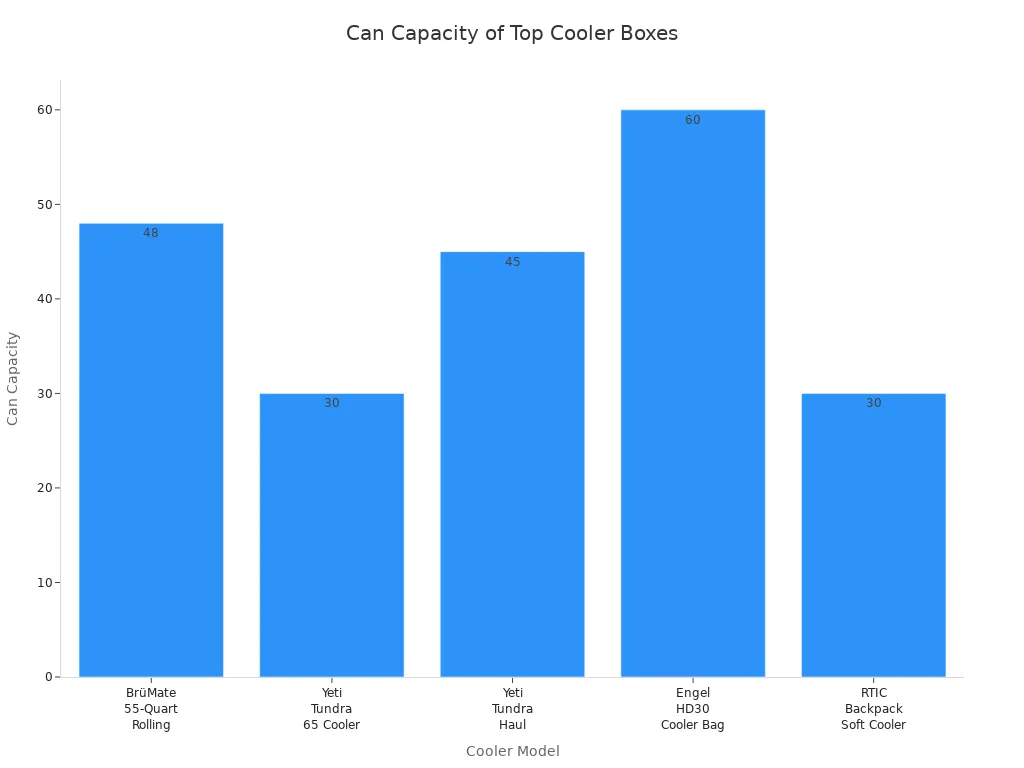
A rolling cooler with wheels, like the BrüMate 55-Quart, makes it easy to serve a crowd. The Yeti Tundra Haul Cooler also offers great portability and insulation. If you want something lighter, a soft cooler or a backpack cooler can help you carry extra drinks. The best soft cooler for groups has multiple handles and a waterproof liner. You can use a backpack cooler for overflow or for carrying drinks to a picnic spot.
Note: For large groups, look for coolers with big capacity, rolling wheels, and easy-to-carry features. A mix of hard and soft coolers gives you flexibility and keeps everyone happy.
How We Tested Huge Cooler Boxes
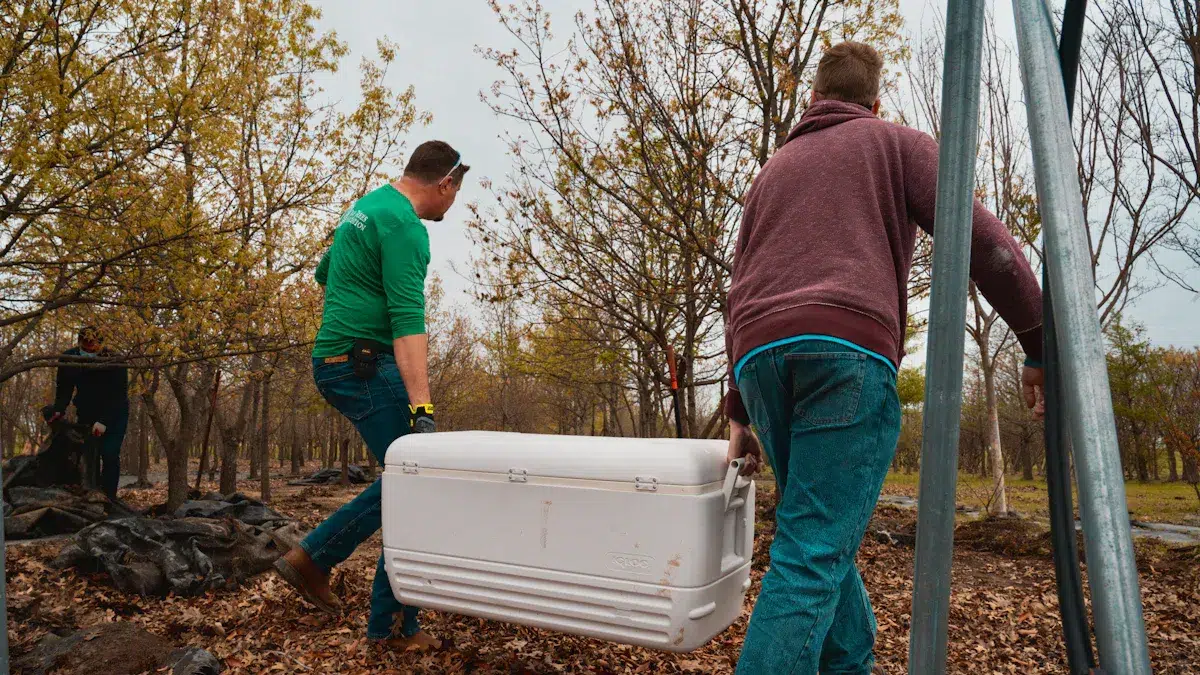
Testing Methodology
You want to know how a cooler performs before you buy it. That’s why we set up a clear testing process. We tested each cooler in the same way to keep things fair. First, we filled every cooler with the same amount of ice and drinks. We placed the coolers in a warm spot, just like you would on a sunny day. We checked the temperature inside each cooler every few hours. We also opened each cooler a set number of times each day, just like you would on a camping trip or picnic.
Here’s a quick look at our steps:
- Fill each cooler with the same amount of ice and drinks.
- Place the coolers in a warm area.
- Open each cooler at regular times to check the temperature.
- Record how long the ice lasts in each cooler.
- Check for leaks, easy opening, and how simple it is to carry each cooler.
This way, you get a real idea of how each cooler works in everyday life.
Real-World Scenarios
Cooler performance can change a lot depending on how you use it. Things like where you put the ice, what kind of insulation the cooler has, and even the outside temperature all matter. For example, using phase change materials (PCMs) in different spots inside the cooler can make a big difference. If you put 20% of the PCM at the top and 20% on each side, and use a PCM with a melting point of 2°C, you can keep things cold for up to 46.5 hours. The type of insulation matters too. Vacuum insulated panels can help your cooler stay cold much longer than regular foam.
Here’s a table showing how different factors affect cooler performance:
| Factor | Description / Effect |
|---|---|
| PCM Arrangement | Different setups tested, like all at the top or split on sides, change cooling time. |
| PCM Melting Point | Lower melting points (like 2°C) keep the cooler cold longer. |
| Insulation Material | Vacuum panels work better than regular foam. |
| Cooling Duration Range | Cooling time can be as short as 2.1 hours or as long as 46.5 hours. |
| Optimal Configuration | Best setup: PCM at top and sides, 2°C melting point, vacuum insulation. |
You can see that real-world use, like how you pack your cooler and what insulation it uses, really changes how long your food and drinks stay cold. Always think about these factors when you pick a cooler for your next trip.
Huge Cooler Box Buying Guide
Key Factors to Consider
Choosing the right cooler can make your trip much better. You want your food and drinks to stay cold, fresh, and safe. Start by thinking about what you need most. Do you want a cooler for a weekend camping trip, a fishing adventure, or a big tailgate party? Each activity needs different features.
Here are some things you should look at:
- Insulation: Good insulation keeps ice from melting fast. Thick walls and tight seals help your cooler hold cold air longer.
- Capacity: Think about how many people you need to serve. A small group needs less space, but a large family or team needs a bigger cooler.
- Portability: If you move your cooler a lot, look for wheels, handles, or backpack straps. Some coolers are heavy, so easy carrying is important.
- Features: Check for things like drain plugs, dry baskets, cup holders, and tie-down points. These features make your cooler easier to use.
- Type: Decide if you want a hard cooler or a soft cooler. Hard coolers give you better insulation and durability. Soft coolers are lighter and easier to carry.
- Trip Length: Short trips need less insulation, but long adventures need a cooler that keeps ice for days.
Tip: Always match the cooler’s features to your trip. You will enjoy your outing more when your cooler fits your needs.
Matching a Hard Cooler to Your Needs
You want your hard cooler to fit your plans. Different activities need different sizes and features. Use this table to help you pick the right cooler for your next adventure:
| Use Case | Recommended Cooler(s) | Capacity & Features | Notes |
|---|---|---|---|
| Weekend Getaway (small group) | Outfitter 35 or 55, PRO 45 | Enough space, strong insulation, easy to carry | Great for short trips |
| Family Camping (3-day) | Outfitter 75, PRO 65 | Large capacity, divider for food prep, thick walls | Good for families |
| Extended Expedition (large group) | Outfitter 125, Prospector 103, PRO 150 | High capacity, top insulation, heavy-duty build | Best for big groups and long trips |
| Day Trips & Picnics | Nomad 20, 30, Outfitter 22 | Lightweight, compact, easy to move | Perfect for tailgating or the beach |
| Active Overnight (small group) | Mule 30 | Backpack style, combines soft cooler and hard shell | Hands-free portability for fishing or hiking |
When you pick a cooler, think about how much you need to carry and how far you need to move it. Hard coolers work best for long trips and rough use. Soft coolers are great for quick outings or when you need something light. Look for features like wheels, handles, and strong insulation. These features help you get the most out of your cooler, no matter where you go.
Note: The right cooler makes your trip easier. Match the size, insulation, and features to your activity for the best results.
When you pick a huge cooler, you want something that keeps ice solid, stands up to rough trips, and lasts for years. YETI leads the pack for performance, durability, and user satisfaction. Experts love its premium durability and ice retention. Other top brands like RTIC, Igloo, KUER, Pelican, and Coleman also shine for different reasons:
- RTIC gives you strong durability and ice retention at a lower price.
- Pelican stands out for military-grade durability and a lifetime warranty.
- Igloo offers innovation, eco-friendly options, and reliable ice performance.
- KUER impresses with premium features and up to 7 days of ice retention.
- Coleman is a classic choice for value and easy use.
| Brand | Price Range | Ice Retention | Durability Strengths |
|---|---|---|---|
| YETI | Premium | Up to 10 days | Top durability, proven build |
| RTIC | Budget-friendly | Up to 8 days | Strong, reliable durability |
| Pelican | Higher | Up to 10 days | Military-grade durability |
| Igloo | Affordable | Good | Innovative, eco-friendly |
You should always choose your cooler based on your trip, group size, and budget. Look for the right mix of durability, ice retention, and features to get the best results.
FAQ
What size cooler box should you get for a family trip?
You want a cooler that holds enough food and drinks for everyone. For a family of four, a 50-70 quart cooler usually works well. If you pack lots of snacks or plan a long trip, go bigger.
How do you make ice last longer in your cooler?
Pack your cooler with pre-chilled items and use large ice blocks. Keep the lid closed as much as possible. Store your cooler in the shade. You can also add extra insulation, like a towel on top.
Can you use dry ice in a huge cooler box?
Yes, you can use dry ice in many hard coolers. Always check the manufacturer’s guidelines first. Handle dry ice with gloves and keep the cooler in a well-ventilated area.
What’s the difference between rotomolded and injection-molded coolers?
Rotomolded coolers have thicker, seamless walls. They keep ice longer and handle rough use better. Injection-molded coolers weigh less and cost less, but may not insulate as well.
How do you clean and store your cooler after use?
Wash your cooler with mild soap and water. Rinse it well and let it dry with the lid open. Store it in a cool, dry place. This keeps your cooler fresh and ready for your next adventure.


